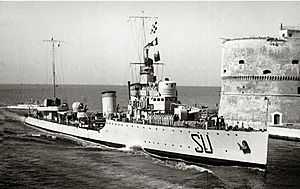Sauro-class destroyer
 Italian destroyer Sauro | |
| Class overview | |
|---|---|
| Operators: |
|
| Preceded by: | Sella class |
| Succeeded by: | Turbine class |
| In commission: | 1927–1941 |
| Completed: | 4 |
| Lost: | 4 |
| General characteristics | |
| Type: | Destroyer |
| Displacement: |
1,058 long tons (1,075 t) standard 1,600 long tons (1,600 t) full load |
| Length: | 90.16 m (295 ft 10 in) |
| Beam: | 9.2 m (30 ft 2 in) |
| Draught: | 2.9 m (9 ft 6 in) |
| Propulsion: |
2 shaft Parsons type geared turbines 3 boilers 36,000 hp (26,800 kW) |
| Speed: | 35 knots (40 mph; 65 km/h) |
| Range: | 2,600 nmi (4,800 km) at 14 knots (16 mph; 26 km/h) |
| Complement: | 156 |
| Armament: |
• 4 × 120 mm (4.7 in) guns (2×2) • 2 × 40 mm pom-pom anti-aircraft guns • 2 × 31.2 mm machine guns • 6 × 533 mm (21 in) torpedo tubes (2×3) • 52 mines |
The Sauro Class were a group of destroyers built for the Italian Navy in the late 1920s. They were based in the Red Sea Italian colony of Eritrea and all fought in World War II being sunk during the East African Campaign in 1941.
These ships were an enlarged version of the Sella-class destroyer, with six rather than four torpedo tubes, a 60 cm increase in beam, and a new bridge structure.
Ships
These ships formed the 3rd Squadrilla and were based in the Red Sea.
- Cesare Battisti -
- Named after patriot Cesare Battisti,
- built by Odero, Sestri Ponente, completed 13 April 1927.
- Based in the Red Sea, Scuttled on 3 April 1941.
- Daniele Manin -
- Named after patriot Daniele Manin,
- built by CNQ Fiume, completed 1 March 1927.
- Based in the Red Sea, she was sunk by aerial bombing on 3 April 1941.
- Francesco Nullo -
- Named after Francesco Nullo,
- built by CNQ Fiume, completed 15 April 1927.
- She was beached 21 October 1940, on Harmil island following a battle with HMS Kimberley. The next day she was destroyed by three RAF Bristol Blenheim bombers.
- Nazario Sauro -
- Named after Italian naval hero Nazario Sauro,
- built by Odero, Sestri Ponente. Completed 23 September 1926.
- She was sunk 3 April 1941 by an Allied bombing.
Operational history
The destroyers were outfitted for colonial service, and by 1935 they were deployed in the naval base of Massawa, Eritrea.[1] Italian's entry in WWII left Italian East Africa isolated from Italy.[2]
Attack on convoy BN 7
The only appreciable action in which the destroyers were involved was the attack on the Allied convoy BN 7, on the first hours of 21 October 1940. The Nullo and Sauro, along with the Leone and Pantera shelled the convoy and its escort, inflicting some splinter damage to the leading transport ship, and launched at least two torpedoes aimed at HMAS Yarra, which successfully dodged them.[3] The attack was nevertheless repulsed by the cruiser HMS Leander, which fired 129 six-inch rounds on the Italian destroyers. While Sauro and the other destroyers successfully disengaged, Nullo was chased by HMS Kimberley and forced to run aground on Harmil island, where she was later wrecked by RAF Blenheim bombers. Kimberley took two hits on a boiler from coastal batteries, and had to be towed to Aden by HMS Leander.
End of the surviving units
The three surviving destroyers remained at dock in Massawa until the very end of ground operations in East Africa. Their commander ordered them to steam out on 2 April 1941, for an almost suicidal attack on Port Sudan. The squadron was soon discovered by British air reconnaissance, and immediately bombed by land-based Swordfish aircraft from HMS Eagle. The Battisti managed to reach the Arabian coast, where she was scuttled by her crew. Manin and Sauro kept firing their antiarcraft guns until they were sunk by the British planes.[4]
Notes
- ↑ Cacciatorpediniere Sauro (Italian)
- ↑ Etnasi, Fernando (2007). Otto milioni di baionette: in guerra con le suole di cartone. EdUP, p. 72. ISBN 88-8421-170-0 (Italian)
- ↑ O'Hara, Vincent P. (2009). Struggle for the Middle Sea: the great navies at war in the Mediterranean theater, 1940-1945. Naval Institute Press, p. 103. ISBN 1-59114-648-8
- ↑ Jackson, Ashley (2006). The British Empire and the Second World War. Continuum International Publishing Group, p. 283. ISBN 1-85285-417-0
References
- Whitley, M.H. (1988). Destroyers of World War 2. Cassell Publishing. ISBN 1-85409-521-8.
| |||||||||||||||||||||||||||||